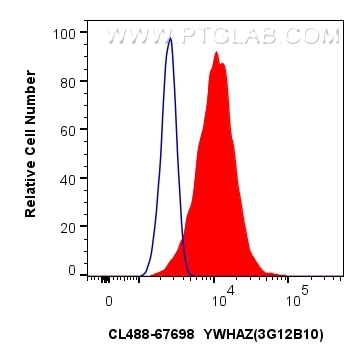Anticorps Monoclonal anti-YWHAZ
YWHAZ Monoclonal Antibody for IF/ICC, FC (Intra)
Hôte / Isotype
Mouse / IgM
Réactivité testée
Humain, rat, souris
Applications
IF/ICC, FC (Intra)
Conjugaison
CoraLite® Plus 488 Fluorescent Dye
CloneNo.
3G12B10
N° de cat : CL488-67698
Synonymes
Galerie de données de validation
Applications testées
| Résultats positifs en IF/ICC | cellules MCF-7, |
| Résultats positifs en FC (Intra) | cellules MCF-7, |
Dilution recommandée
| Application | Dilution |
|---|---|
| Immunofluorescence (IF)/ICC | IF/ICC : 1:50-1:500 |
| Flow Cytometry (FC) (INTRA) | FC (INTRA) : 0.40 ug per 10^6 cells in a 100 µl suspension |
| It is recommended that this reagent should be titrated in each testing system to obtain optimal results. | |
| Sample-dependent, check data in validation data gallery | |
Informations sur le produit
CL488-67698 cible YWHAZ dans les applications de IF/ICC, FC (Intra) et montre une réactivité avec des échantillons Humain, rat, souris
| Réactivité | Humain, rat, souris |
| Hôte / Isotype | Mouse / IgM |
| Clonalité | Monoclonal |
| Type | Anticorps |
| Immunogène | YWHAZ Protéine recombinante Ag6667 |
| Nom complet | tyrosine 3-monooxygenase/tryptophan 5-monooxygenase activation protein, zeta polypeptide |
| Masse moléculaire calculée | 28 kDa |
| Poids moléculaire observé | 28-30 kDa |
| Numéro d’acquisition GenBank | BC003623 |
| Symbole du gène | YWHAZ |
| Identification du gène (NCBI) | 7534 |
| Conjugaison | CoraLite® Plus 488 Fluorescent Dye |
| Excitation/Emission maxima wavelengths | 493 nm / 522 nm |
| Forme | Liquide |
| Méthode de purification | Précipitation de l'acide caprylique/du sulfate d'ammonium |
| Tampon de stockage | PBS with 50% glycerol, 0.05% Proclin300, 0.5% BSA |
| Conditions de stockage | Stocker à -20 °C. Éviter toute exposition à la lumière. Stable pendant un an après l'expédition. L'aliquotage n'est pas nécessaire pour le stockage à -20oC Les 20ul contiennent 0,1% de BSA. |
Informations générales
YWHAZ (also known as 14-3-3 zeta) is a member of 14-3-3 proteins which were the first phosphoserine/phosphothreonine-binding proteins to be discovered. 14-3-3 family members interact with a wide spectrum of proteins and possess diverse functions. Mammals express seven distinct 14-3-3 isoforms (gamma, epsilon, beta, zeta, sigma, theta, tau) that form multiple homo- and hetero- dimmers. 14-3-3 proteins display the highest expression levels in the brain, and have been implicated in several neurodegenerative diseases, including Alzheimer's disease and amyotrophic lateral sclerosis.
Protocole
| Product Specific Protocols | |
|---|---|
| IF protocol for CL Plus 488 YWHAZ antibody CL488-67698 | Download protocol |
| FC protocol for CL Plus 488 YWHAZ antibody CL488-67698 | Download protocol |
| Standard Protocols | |
|---|---|
| Click here to view our Standard Protocols |



